Coronavirus (COVID-19): modelling the epidemic (issue no. 20)
Latest findings in modelling the COVID-19 epidemic in Scotland, both in terms of the spread of the disease through the population (epidemiological modelling) and of the demands it will place on the system, for example in terms of health care requirement
Coronavirus (COVID-19): modelling the epidemic in Scotland (Issue No. 20)
Background
This is a report on the Scottish Government modelling of the spread and level of Covid-19. This updates the previous publication on modelling of Covid-19 in Scotland published on 23 September 2020. The estimates in this document help the Scottish Government, the health service and the wider public sector plan and put in place what is needed to keep us safe and treat people who have the virus.
This edition of the research findings focuses on the epidemic as a whole, looking at estimates of R, growth rate and incidence.
Key Points
- The reproduction rate R in Scotland is currently estimated as being between 1.3 and 1.7.
- The number of new daily infections for Scotland is estimated as being between 21 and 83, per 100,000 people.
- The growth rate for Scotland is estimated as being between +5% and +10%.
- The estimated doubling time for Scotland was between 7.6 and 12.1 days.
Overview of Scottish Government Modelling
Epidemiology is the study of how diseases spread within populations. One way we do this is using our best understanding of the way the infection is passed on and how it affects people who catch it to create mathematical simulations. Because people who catch Covid-19 have a relatively long period in which they can pass it on to others before they begin to have symptoms, and the majority of people infected with the virus will experience mild symptoms, this "epidemiological modelling" provides insights into the epidemic that cannot easily be measured through testing e.g. of those with symptoms, as it estimates the total number of new daily infections and infectious people, including those who are asymptomatic or have mild symptoms.
Modelling also allows us to make short-term forecasts of what may happen with a degree of uncertainty. These can be used in health care and other planning. The modelling in this research findings is undertaken using different types of data which going forward aims to both model the progress of the epidemic in Scotland and provide early indications of where any changes are taking place.
Modelling outputs are provided here on the current epidemic in Scotland as a whole, based on a range of methods. Because it takes a little over three weeks on average for a person who catches Covid-19 to show symptoms, become sick, and either die or recover, there is a time lag in what our model can tell us about any re-emergence of the epidemic and where in Scotland this might occur. However modelling of Covid deaths is an important measure of where Scotland lies in its epidemic as a whole. In addition the modelling groups which feed into the SAGE consensus use a range of other data along with deaths in their estimates of R and growth rate. These outputs are provided in the first part of this research findings. This week the type of data used in each model to estimate R is highlighted in Figure 2.
A short term forecast of the number of cases in the next two weeks is also provided, as the focus at this stage of the epidemic is the re-emergence of the virus in Scotland rather than whether there is sufficient hospital capacity to treat large numbers of Covid cases.
What the modelling tells us about the epidemic as a whole
Figure 1 shows how Rt has changed since February. Before the "stay at home" restrictions were put in place Rt was above 1, and most likely to have been between 2 and 4 before any interventions were put in place.
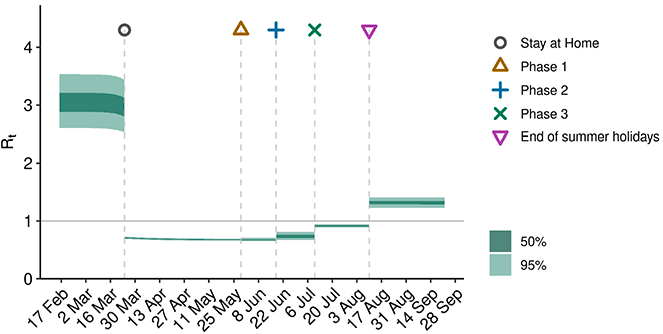
Graph description
A graph showing the trends in the Rt value for Scotland over time, as calculated by the model. The graph shows step changes downwards at the point when each intervention was introduced. This figure shows Rt fell below 1.0 on the 23rd of March, when the “stay at home” advice was given. The Rt has been above 1 since around the time the school summer holidays ended.
Source: Scottish Government modelled estimates using Imperial College model code; actual data from https://www.nrscotland.gov.uk/statistics-and-data/statistics/statistics-by-theme/vital-events/general-publications/weekly-and-monthly-data-on-births-and-deaths/deaths-involving-coronavirus-covid-19-in-scotland
The various groups which report to the Scientific Pandemic Influenza Group on Modelling (SPI-M) use different sources of data in their models (i.e. deaths, hospital admissions, cases) so their estimates of R are also based on these different methods. SAGE's consensus view across these methods, as of 30 September, was that the value of Rt in Scotland was above 1, between 1.3 and 1.7, meaning that the epidemic is growing exponentially. The R value estimated by the Scottish Government falls within this range, and is similar to the estimates of other modelling groups (Figure 2).
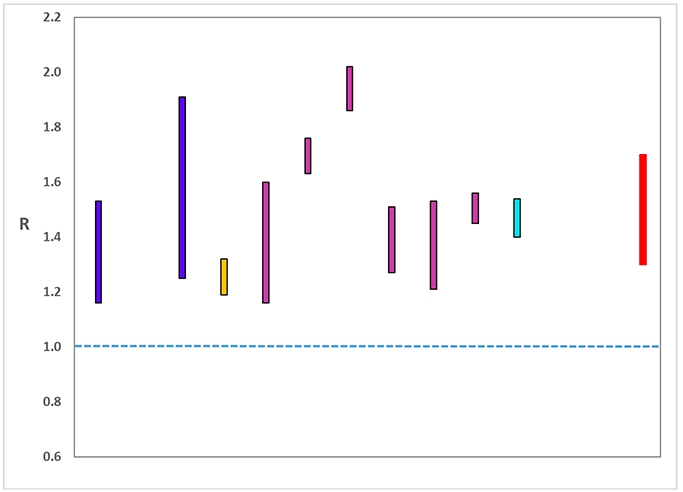
Graph description
A graph showing the range of values which each of the academic groups reporting an R value to SAGE are likely to lie within, as of 30th September. The blue bars (first and second from left) is a death-based model, purple (4th to 9th from the left) use multiple sources of data and cyan (10th from the left) use Covid-19 test results. The estimate produced by the Scottish Government (a deaths-based model) is the 3rd from left (yellow). The R value estimated by the Scottish Government is similar to the estimates of other groups using models which draw upon numbers of deaths. The SAGE consensus, shown at the right hand side of the plot, is that the most likely “true” range is between 1.3 and 1.7.
Source: Scientific Advisory Group for Emergencies (SAGE).
On 29 September, Public Health Scotland recorded 806[1] positive new cases, with 2709 positive new cases over the week of 22 – 28 September.
The various groups which report to the Scientific Pandemic Influenza Group on Modelling (SPI-M) use different sources of data in their models to produce estimates of incidence. SPI-M's consensus view across these methods, as of 23 September, was that the incidence of new daily infections in Scotland was between 21 and 83 new infections per 100,000. This equates to between 1,160 – 4,600 people becoming infected each day in Scotland.
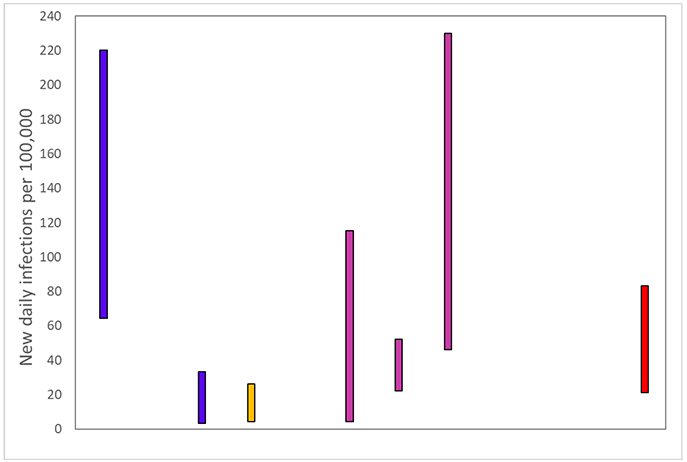
Graph description
A graph showing the ranges the values which each of the academic groups in SPI-M are reporting for incidence (new daily infections per 100,000) are likely to lie within, as of 30th September. The blue bars are death based models (1st and 2nd from left). The purple bars (4th to 6th from the left) use multiple sources of data. The estimate produced by the Scottish Government (a deaths-based model) is the 3rd from the left (yellow). The SAGE consensus (21 to 83 new daily infections per 100,000) is shown at the right hand side of the plot.
Source: Scientific Pandemic Influenza Group on Modelling (SPI-M).
The consensus from SAGE for this week is that the growth rate in Scotland is between +5% and +10% per day. This is higher than last week, when the growth rate was in the range +4% to +9%.
The spread of the epidemic can be expressed in terms of the length of time it takes for numbers of new daily cases to double. Doubling times were provided by SPI-M on 30 September. The consensus estimated doubling time for Scotland was between 7.6 and 12.1 days.
Figure 4 shows the epidemiological model forecasts of daily deaths produced by the Scottish Government, given the present set of interventions. This measure of the epidemic is forecast to increase in the weeks ahead.
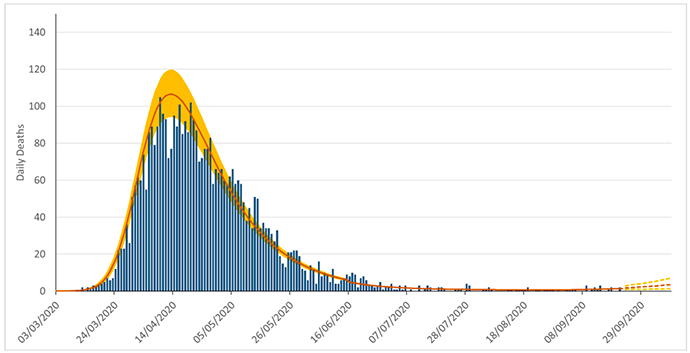
Chart description
A bar chart showing daily numbers of deaths caused by Covid-19 in Scotland between 12th March and 22nd September, 2020. Overlain on this is the “estimated deaths” result from the model, which smooths out the cyclical weekly pattern in the reported numbers, due to fewer deaths being registered over a weekend.
Source: Scottish Government modelled estimates using Imperial College model code; actual data from https://www.nrscotland.gov.uk/statistics-and-data/statistics/statistics-by-theme/vital-events/general-publications/weekly-and-monthly-data-on-births-and-deaths/deaths-involving-coronavirus-covid-19-in-scotland
The logistical model developed by Scottish Government analysts to assess implications for health care demand (see previous Research Findings) has been adapted to produce a short-term forecast of cases.
The following two week ahead predictions use this model to extend the estimated number of infections from the Imperial College model, in a manner that fits with the estimated number of actual cases, adjusting positive tests to account for asymptomatic and undetected infections.
The extension begins in mid-July, and assumes an R0 value rising to 1.6. Future R0 values are based on agreed assumptions.
Figure 5 shows two predictions from this model - a "better scenario", which assumes the current R0 value was reduced as a result of new measures announced on 22 September, and a "worse scenario", which assumes that transmission remained the same.
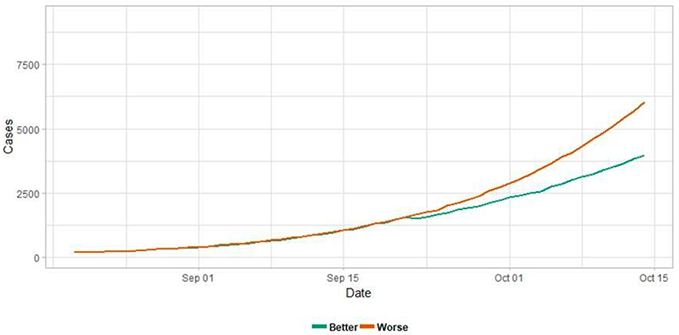
Graph description
A line graph showing the two week ahead better and worse scenario predictions using the logistics model to extend the estimated number of infections from the Imperial College model in a manner that fits with the number of actual cases. The worse scenario indicates around 6000 cases, whereas the better scenario indicates around 4000 cases in two weeks.
Exceedance is a tool which helps us to spot hotspots of Covid where the number of new cases exceeds what was expected. As cases rise across the country, it becomes less informative as the background level of expected cases increases. As a result, this will not be reported this week.
A new tranche of results are available from the Scottish Contact Survey (SCS). These are currently being processed, and the results will be presented in future weeks.
What next?
The Scottish Government continues to work with a number of academic modelling groups to develop other estimates of the epidemic in Scotland.
The modelled estimates of the numbers of new cases and infectious people will continue to be provided as measures of the epidemic as a whole, along with measures of the current point in the epidemic such as exceedance. Rt and growth rate will also be provided. Further information can be found at https://www.gov.scot/coronavirus-covid-19.
Contact
There is a problem
Thanks for your feedback